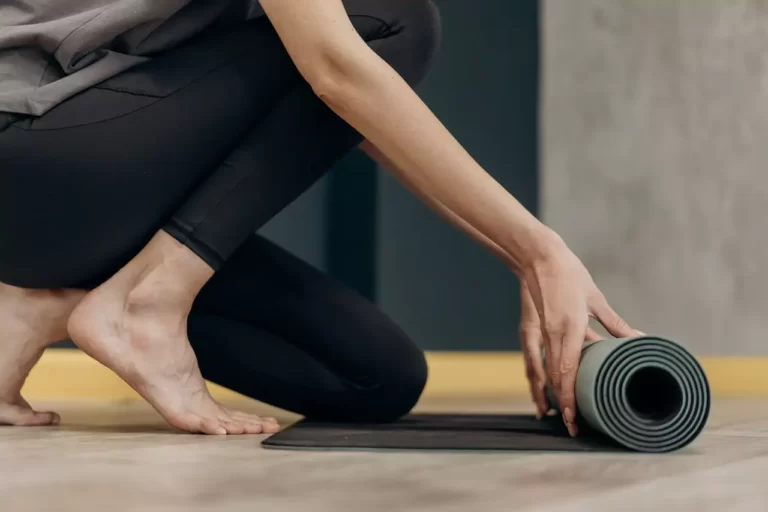Ayurvedic Yoga Mat: A Natural and Sustainable Option for Your Practice

As yoga practitioners, we strive to align our mind, body, and spirit in our practice. However, we often neglect to consider the impact our yoga mat has on the environment and our health. This is where the ayurvedic yoga mat comes in, offering a natural and sustainable option for our daily practice.
An ayurvedic yoga mat is made from organic and natural materials, free from toxic substances commonly found in traditional mats. It is a non-slip and breathable mat that provides stability during asanas while promoting a comfortable and enjoyable practice. Its use aligns with the principles of Ayurveda, a holistic wellness practice that focuses on balancing mind, body, and spirit.
What Makes an Ayurvedic Yoga Mat Different?
When it comes to finding the perfect yoga mat, there are a lot of options out there. However, if you’re looking for a natural and sustainable choice, an ayurvedic yoga mat may be the perfect fit for you. Here are some of the distinguishing features that make an ayurvedic yoga mat stand out:
| Features | Description |
|---|---|
| Organic and Natural Materials | An ayurvedic yoga mat is typically made from natural materials like cotton, jute, or rubber, and is free from synthetic materials. |
| Eco-Friendly | These mats are designed with the environment in mind, often being biodegradable and made from sustainable materials. |
| Non-Toxic | An ayurvedic yoga mat is free from harmful chemicals, ensuring that you can practice safely and without exposing yourself to toxins. |
| Sustainable | These mats are made to last, reducing the need for frequent replacements and minimizing their impact on the environment. |
An ayurvedic yoga mat is the perfect choice for practitioners who want to prioritize their health and the health of the planet. Not only will you be supporting sustainable practices, but you’ll also be investing in a durable and safe mat that will support your practice for years to come.
The Benefits of Using an Ayurvedic Yoga Mat
Practicing yoga on a regular basis provides numerous physical, mental, and spiritual benefits. When combined with an ayurvedic yoga mat, the practice becomes even more enriching and fulfilling.
One key benefit of using an ayurvedic yoga mat is its non-slip surface. This provides the necessary stability and support during challenging asanas and poses, helping to prevent injuries. Additionally, the mat’s natural materials allow for better grip and traction, so practitioners can move through their practice with confidence.
Another advantage of an ayurvedic yoga mat is its breathability. Unlike synthetic materials, natural materials such as cotton and rubber allow for air to circulate through the mat, preventing excess sweat buildup and making for a more comfortable and enjoyable practice.
Overall, the use of an ayurvedic yoga mat enhances the overall yoga experience, allowing practitioners to immerse themselves in the practice and connect more deeply with their mind, body, and spirit.
The Connection Between Ayurveda and Yoga
Ayurveda and yoga are two holistic practices that work in tandem to promote wellness and balance in the body and mind. Both originated in ancient India and share a deep connection.
At the core of Ayurveda is the belief that each person has a unique mind-body constitution, or dosha, that determines their physical, mental, and emotional characteristics. Yoga, on the other hand, is a practice that involves physical postures, breathing techniques, and meditation to promote flexibility, strength, and relaxation.
Together, Ayurveda and yoga can help individuals achieve optimal health and well-being by addressing imbalances in the body and mind. Practicing yoga can help balance the doshas and promote physical and mental harmony. Using an ayurvedic yoga mat can enhance this experience by providing a natural and sustainable surface to practice on.
Choosing the Right Ayurvedic Yoga Mat for You
When selecting an ayurvedic yoga mat, there are many factors to consider to ensure you find the right one for your practice.
The first thing to consider is thickness. Mats typically range from 1/16 inch to 1/4 inch thickness. A thinner mat may be best for those who prioritize portability, while a thicker mat provides more cushioning and joint support.
Texture is another important factor. Some mats have a smooth surface, while others have a textured surface for added grip. Consider your preference and the type of yoga you practice when selecting a mat.
The grip of your mat is crucial for a safe practice. Look for a non-slip mat that will provide stability and support during poses.
For those who prioritize sustainability, look for mats with certifications such as OEKO-TEX and GOTS, ensuring they are made with sustainable and organic materials. Biodegradable mats are also available for those who want to minimize their environmental impact.
Overall, an ayurvedic yoga mat is a natural and sustainable option that can enhance your practice while aligning with your values.
Caring for Your Ayurvedic Yoga Mat
Proper care and maintenance of your ayurvedic yoga mat is crucial to ensure its longevity and sustainability. Here are some tips on how to care for your mat:
| Tip | Method |
|---|---|
| Clean your mat | Wipe down your mat with a damp cloth or sponge using mild soap or detergent. Alternatively, mix equal parts water and vinegar in a spray bottle and spritz your mat before wiping it down. Avoid using harsh chemicals or bleach as they may damage the natural materials. |
| Air dry your mat | Avoid using a dryer or exposing your mat to direct sunlight as it may cause the natural rubber to deteriorate. Instead, hang or lay your mat flat in a well-ventilated area, away from direct heat or sunlight. |
| Store your mat properly | Roll your mat with the top side facing out and store it in a dry and cool place. Avoid folding or creasing your mat, as it may cause permanent damage. |
By following these tips, you can help prolong the life of your ayurvedic yoga mat and reduce your environmental impact.
Ayurvedic Yoga Mat vs. Traditional Yoga Mat
When it comes to choosing a yoga mat, there are countless options available. Traditional mats are often made with synthetic materials, such as PVC, which can be harmful to both your health and the environment. On the other hand, ayurvedic yoga mats are natural, non-toxic, and sustainable. Let’s explore some of the key differences between these two types of mats.
Material
Traditional yoga mats are typically made from synthetic materials, such as PVC or rubber. These materials can be harmful to both your health and the environment, as they often contain chemicals and are not biodegradable. Ayurvedic yoga mats, on the other hand, are made from natural materials such as organic cotton, jute, and natural rubber. These materials are non-toxic, eco-friendly, and biodegradable.
Sustainability
Traditional yoga mats are often not sustainable, as they are made from non-biodegradable materials and can end up in landfills. Ayurvedic yoga mats, on the other hand, are sustainable and environmentally friendly. They are made from natural materials that can biodegrade over time.
Grip
One of the most important features of a yoga mat is its grip. Traditional mats often have a synthetic surface that can be slippery and unsafe, especially when practicing more advanced poses. Ayurvedic yoga mats, however, have a natural grip due to their use of natural rubber and jute. This allows for a safer and more stable practice.
Overall, the choice between a traditional and ayurvedic yoga mat comes down to personal preference. However, if you are looking for a natural, non-toxic, and sustainable option that provides a safe and comfortable practice, an ayurvedic yoga mat is the way to go.
Ayurvedic Yoga Mat FAQs
Below are answers to some of the frequently asked questions about ayurvedic yoga mats:
- Are ayurvedic yoga mats durable?
Yes, ayurvedic yoga mats are made of high-quality, natural materials that are designed to last. With proper care and maintenance, they can last for many years. - Do ayurvedic yoga mats have an odor?
Some ayurvedic yoga mats may have a slight natural scent due to the use of organic materials. However, this should dissipate over time and with proper airing out. - Can I use an ayurvedic yoga mat for hot yoga?
Yes, many ayurvedic yoga mats are designed to be slip-resistant, making them a great option for hot yoga and other styles of yoga that involve sweating. - Are ayurvedic yoga mats suitable for beginners?
Yes, ayurvedic yoga mats are suitable for practitioners of all levels, including beginners. They provide a natural and supportive surface for practicing yoga in a safe and comfortable way. - Do ayurvedic yoga mats come in different sizes?
Yes, ayurvedic yoga mats come in a variety of sizes to suit different body types and practice styles. Be sure to choose a mat that is the appropriate length and width for your needs.
If you have any other questions about ayurvedic yoga mats, feel free to reach out to the manufacturer or retailer for more information.
Ayurvedic Yoga Mat Conclusion
Switching to an ayurvedic yoga mat is a great way to elevate your practice and prioritize your health and wellness. With its use of organic and natural materials, it’s an eco-friendly and non-toxic option that’s also sustainable and biodegradable. Choosing the right mat for you is important, with factors such as thickness, texture, and grip being key considerations.
Proper care and maintenance of your ayurvedic yoga mat will ensure its longevity and sustainability, and cleaning it with natural, non-toxic products is key. By choosing an ayurvedic yoga mat, you are also aligning with the principles of Ayurveda and its connection with yoga.
Make the Switch Today
By choosing an ayurvedic yoga mat, you’re making a conscious choice to prioritize your health and the environment. With its numerous benefits and natural qualities, it’s the perfect addition to any yogi’s practice. So why wait? Make the switch to an organic and eco-friendly ayurvedic yoga mat today and start experiencing the difference for yourself.





